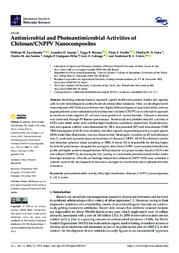Antimicrobial and Photoantimicrobial Activities of Chitosan/CNPPV Nanocomposites.
Antimicrobial and Photoantimicrobial Activities of Chitosan/CNPPV Nanocomposites.
Autoria: FACCHINATTO, W. M.; ARAUJO, L. O.; MORAES, T. B.; ABELHA, T. F.; LIMA, T. H. N.; SANTOS, D. M. dos; CAMPANA-FILHO, S. P.; COLNAGO, L. A.; CAIRES, A. R. L.
Resumo: Multidrug-resistant bacteria represent a global health and economic burden that urgently calls for new technologies to combat bacterial antimicrobial resistance. Here, we developed novel nanocomposites (NCPs) based on chitosan that display different degrees of acetylation (DAs), and conjugated polymer cyano-substituted poly(p-phenylene vinylene) (CNPPV) as an alternative approach to inactivate Gram-negative (E. coli) and Gram-positive (S. aureus) bacteria. Chitosan?s structure was confirmed through FT-Raman spectroscopy. Bactericidal and photobactericidal activities of NCPs were tested under dark and blue-light irradiation conditions, respectively. Hydrodynamic size and aqueous stability were determined by DLS, zeta potential (ZP) and time-domain NMR. TEM micrographs of NCPs were obtained, and their capacity of generating reactive oxygen species(ROS) under blue illumination was also characterized. Meaningful variations on ZP and relaxationtime T2 confirmed successful physical attachment of chitosan/CNPPV. All NCPs exhibited a similarand shrunken spherical shape according to TEM. A lower DA is responsible for driving higher bactericidal performance alongside the synergistic effect from CNPPV, lower nanosized distribution profile and higher positive charged surface. ROS production was proportionally found in NCPs with and without CNPPV by decreasing the DA, leading to a remarkable photobactericidal effect underblue-light irradiation. Overall, our findings indicate that chitosan/CNPPV NCPs may constitute a valuable asset for the development of innovative strategies for inactivation and/or photoinactivation of bacteria
Ano de publicação: 2022
Tipo de publicação: Artigo de periódico
Unidade: Embrapa Instrumentação
Palavras-chave: Blue-light irradiation, CNPPV, Photoantimicrobial activity, S aureus
Observações
1 - Por padrão são exibidas publicações dos últimos 20 anos. Para encontrar publicações mais antigas, configure o filtro ano de publicação, colocando o ano a partir do qual você deseja encontrar publicações. O filtro está na coluna da esquerda na busca acima.
2 - Para ler algumas publicações da Embrapa (apenas as que estão em formato ePub), é necessário ter, no celular ou computador, um desses softwares gratuitos. Sistemas Android: Google Play Livros; IOS: iBooks; Windows e Linux: software Calibre.
Acesse outras publicações
Acesse a Base de Dados da Pesquisa Agropecuária (BDPA) para consultar o acervo completo das bibliotecas da Embrapa.

